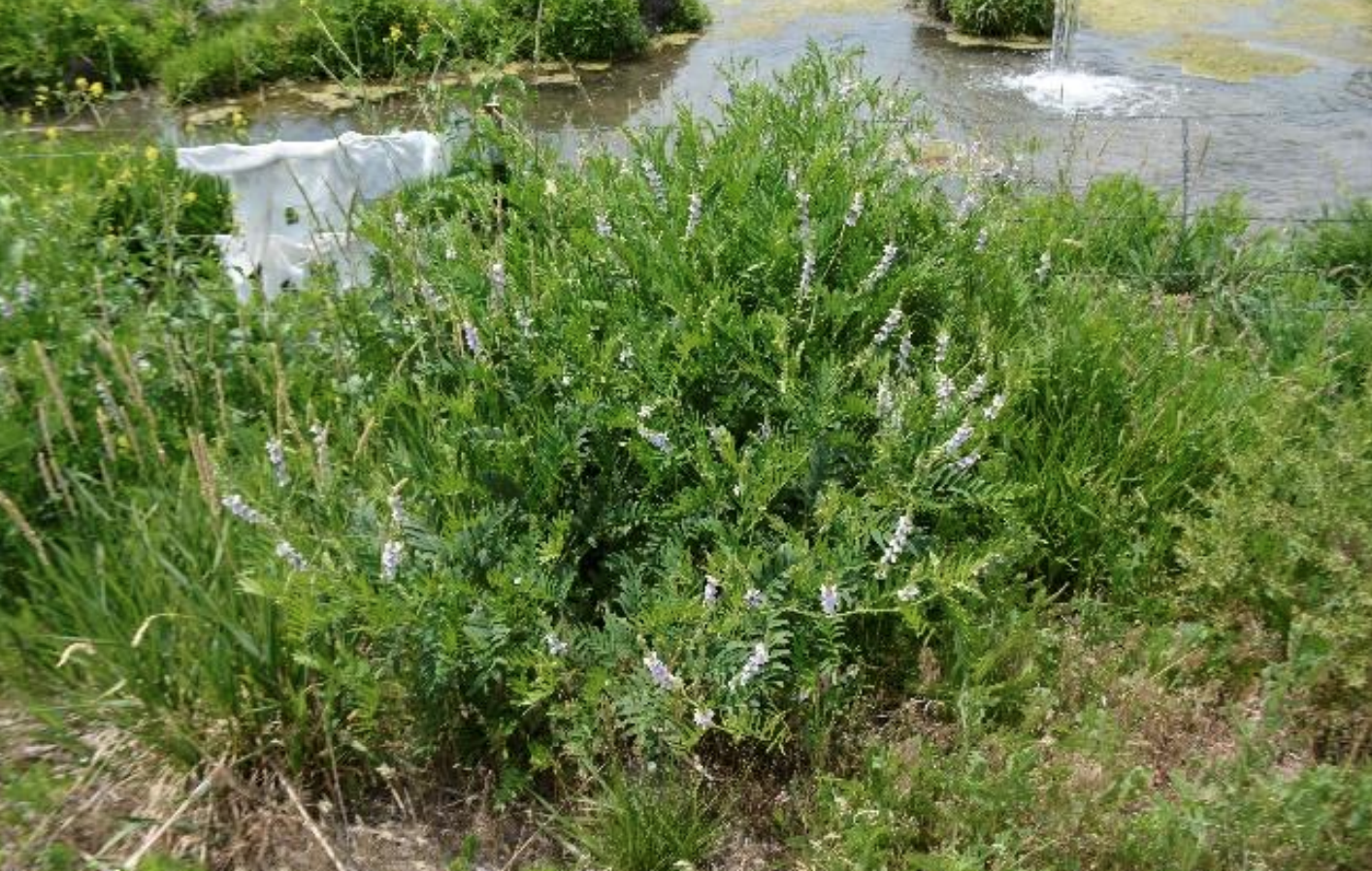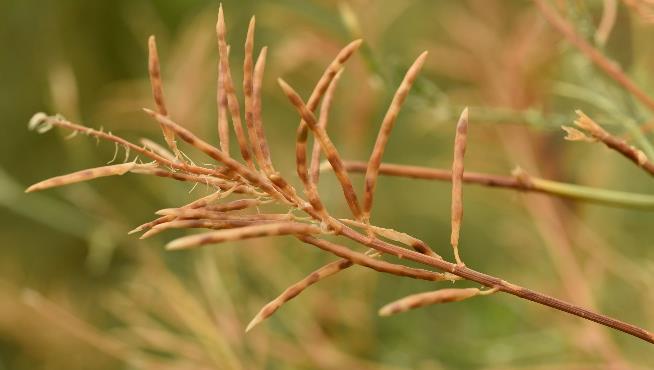Goatsrue (Galega officinalis) Identification and Management in Pastures and Croplands

usually begins in May and continues until fall frost.
Goatsrue Quick Facts
- Flourishes in riparian areas.
- Singe plant can produce 10,000 to 15,000 seeds.
- Well adapted to irrigated settings.
Introduction
Goatsrue is an aggressive invasive plant and a declared Utah state noxious weed (Category 1B). It was introduced into the Cache Valley in 1891 and spread through the irrigation canals, streams, and rivers of the Bear River drainage. Cache County has one of the largest goatsrue infestations in the nation. Luckily, only small infestations are found in neighboring counties (Box Elder, Rich, Weber, and Davis). With government funding assistance, goatsrue was almost eliminated from Cache County in the early 1990s. After funding stopped, goatsrue populations surged, but recently, the Cache County Vegetation Management Division helped to control and manage new establishments.
Goatsrue’s rapid growth, prolific seed production, and ability to spread quickly through waterways make it a problem and concern for many residents of Cache County. Properly identifying and managing goatsrue can help reduce the size of large infestations, eliminate small infestations, and limit its spread.

plants contain 6–10 pairs of leaflets on each leaf. This
leaf structure is known as odd-pinnate, as leaflets
are matched in pairs with one terminal leaf at
the end.
Identification
Goatsrue is a perennial legume that grows from 2 to 6 feet tall. Plants consist of compound leaves, meaning each leaf is made of smaller leaflets. Leaves on mature plants contain 6–10 pairs of oddpinnate leaflets (Figure 2). Flowers grow along main or side stem ends in a pea-like flower stalk from early summer until frost and vary from purple to white (Figure 3). Each flower blossom produces a single seedpod that can produce up to nine beanshaped seeds (Figure 4). A single plant can produce 10,000 to 15,000 seedpods in one year, which are often transported through waterways. Ongoing research at Utah State University found that goatsrue seeds can remain viable in the soil for at least 11 years, with data suggesting even longer seed viability. Goatsrue flourishes in areas with high soil moisture, such as wetlands and waterways, but can also be found in pastures and even home landscapes. Goatsrue is often confused with wild licorice due to similar-looking leaves.

terminal racemes, are purple to white, and grow
from early summer to fall frost.
Management
Prevention
When managing any noxious weed, the first and preferred approach is prevention. Begin by scouting areas where infestations have occurred or areas where new infestations are likely to occur. Ditch banks, waterways, fence lines, irrigated cropland, and pastures are likely places for goatsrue infestations. Carefully clean equipment and tools after working in infested areas to help limit the spread to other areas. Once identifying a goatsrue infestation, it is essential to apply multiple management methods to control this noxious weed.
Cultural Methods
Good cultural practices help manage goatsrue in irrigated croplands and pastures. In croplands, utilizing an alternate cropping strategy or raising row crops effectively manages goatsrue. Both strategies interrupt the goatsrue lifecycle, making establishment difficult. In pastures, maintaining healthy and vigorously growing grasses is the best way to deter goatsrue infestations from the beginning. Proper fertilizing, irrigation, seeding, and grazing create favorable conditions for pasture grasses, making them more competitive. On the other hand, over-irrigation or overgrazing can weaken pasture grasses and create an ideal environment for goatsrue to flourish. Livestock grazing is not a potential method of control because goatsrue is toxic and unpalatable to livestock. An established and healthy pasture can often be the best defense against noxious weeds.

seed pod can contain up to nine bean-shaped seeds.
Mechanical Methods
If done correctly, mechanically removing goatsrue can be an effective control. However, if methods such as cultivation fail to remove or damage goatsrue’s deep taproot, these methods are ineffective and can lead to increased seed distribution. Due to goatsrue’s water-loving nature, cultivation can be difficult or impossible because many plants are located on ditch banks and unworkable areas. Excavation along waterways can destroy goatsrue plants but usually distributes seed into new areas. Utilizing a mower can help limit seed spread, but mowing must occur frequently from early spring until the first frost to prevent seed production, which can be very labor intensive. No biocontrol methods for goatsrue are available at this time. Table 1 summarizes these non-herbicide control methods.
| Table 1: Summary of Non-Herbicide Options for Controlling Goatsrue (Galega officinalis) | |
|---|---|
| Control method | Notes |
| Prevention | |
|
|
| Cultural and mechanical | |
| Cropland |
|
| Pasture and rangeland |
|
| Non-crop and right-of-way |
|
| Biocontrol | |
|
|
Chemical Control
Control goatsrue infestations by using one or more of the herbicides listed in Table 2. Before using any herbicide, always read the label; it is against the law and unsafe to do otherwise. While reading the label, pay special attention to safety requirements, restrictions of use, directions for use, and disposal requirements.
The herbicide label will dictate what areas can be treated with a particular product and restrict options for use under specific site conditions. At the target location, be aware of your surroundings. Slope, vegetation nearby, temperature, and wind can all have a major effect on applying chemical herbicides. When using herbicides to treat goatsrue, it is important to check the target area’s surroundings for water. Goatsrue plants are often found in creeks, ditch banks, and rivers. If not approved for use around water, then you must select another herbicide.
Because goatsrue is a perennial plant, postemergence herbicides are the most effective choice for control. It is important to read the label of postemergence herbicides to know if they are selective (target a specific group of plants) or nonselective (kill most if not all growing plants). Usually, non-selective herbicides are used for seedbed preparation or in areas unfit for vegetation. Keep in mind that many herbicides are most effective when applied to plants when sugars produced in the leaves are moving to roots (i.e., at full flower or after the first frost). Applications to early-growth goatsrue may burn it back, but it will often regrow, requiring additional applications.
Many herbicides do not list goatsrue on their labels because of its limited distribution across the United States. However, research at Utah State University identified products and active ingredients that may effectively control goatsrue, and some of the information is provided in Table 2.
| Table 2: Summary of Herbicide Options | |||
|---|---|---|---|
| Herbicide | |||
| Site and application | Active ingredient | Trade name | Comments |
| Pasture | |||
| Chlorsulfurona | Telar | Showed 93% control of goatsrue.b | |
| Imazapyra | Several | Non-selective herbicide. Spot treatment in pastures. Some formulations are registered for aquatic use. Not safe for use around irrigation water.b | |
| Dicambaa | Several | Do not apply directly to water or where surface water is present. Showed 93% control of goatsrue. | |
| 2,4-D + dicambaa |
Several | Do not apply directly to water or where surface water is present. | |
| Aminopyralida | Milestone | Do not use near ditch banks. Applied postemergence and provided some residual the next year. Non-crop and permanent pasture uses. Decreased goatsrue seedling cover up to 11 months after treatment.b | |
| Piclorama | Tordon | Restricted use pesticide! Do not apply near water sources used for irrigation or domestic purposes. Decreased goatsrue seedling cover up to 11 months after treatment.b | |
| Triclopyra | Several | Showed 93% control of goatsrue.b The 3a formulation (e.g., Garlan 3a) can be used near and over non-irrigation water. | |
| 2,4-D | Several | Non-selective broadleaf herbicide. 2,4-D has been seen to suppress goatsrue, but it is generally less effective and consistent than other listed herbicide products. | |
| Alfalfa | |||
| Imazamoxa | Raptor | Registered for use in alfalfa. Labelled prior to 3 inches of growth or regrowth on established alfalfa. Showed 93% control of goatsrue.b | |
| Rangeland | |||
| Imazapyra | Several | Non-selective herbicide. Spot treatment in pastures. Not safe for use around waterways. | |
| Dicambaa | Several | Do not apply directly to water or where surface water is present. Showed 93% control of goatsrue.b | |
| 2,4-D + dicamba |
Several | Do not apply directly to water or where surface water is present. | |
| Chlorsulfurona | Telar | Showed 93% control of goatsrue.b | |
| Triclopyra | Several | Showed 93% control of goatsrue.b | |
| Piclorama | Tordon | Restricted use Pesticide! Do not apply near water sources used for irrigation or domestic purposes. Decreased goatsrue seedling cover up to 11 months after treatment.b | |
| Aminopyralida | Milestone | Do not use near ditch banks. Typically applied postemergence with some residual the next year. Non-crop and permanent pasture uses. Decreased goatsrue seedling cover up to 11 months after treatment.b | |
| 2,4-D | Several | 2,4-D can suppress goatsrue but is generally less effective and consistent than other listed herbicide products. | |
a Herbicide labels do not contain goatsrue on label; however, research done by Oldham et al. (2009) found these herbicides have success in controlling goatsrue. Applications for these studies were made in the summer to goatsrue plants in full flower.
b Oldham et al., 2009.
Picture Credits
All photos by C. Ransom or J. Hadfield.
References
- Lowry, B. J., Ransom, C., Whitesides, R., & Olsen, H. (2017). Noxious weed field guide for Utah. All Current Publications. Paper 1352. Utah State University Extension. https://digitalcommons.usu.edu/extension_curall /1352
- Oldham, M. (2009). Goatsrue (Galega officinalis) seed biology, control, and toxicity [Master’s thesis, Utah State University]. All Graduate Theses and Dissertations. 235. https://digitalcommons.usu.edu/etd/235
- Oldham, M., & Ransom, C.V. (2009). Goatsrue (Galega officinalis) seed biology. Weed Science, 57(2), 149–154. https://doi.org/10.1614/wt-d-10-00003.1
- Oldham, M., & Ransom, C.V. (2010). Goatsrue (Galega officinalis) response to herbicides. Weed Technology: A Journal of the Weed Science Society of America, 25(1), 70–76. https://doi.org/10.1614/wt-d-10-00003.1
- Oldham, M., Ransom C.V., Ralphs, M.H., & Gardner, D. (2011). Galegine content in goatsrue (Galega officinalis) varies by plant part and phenological growth stage. Weed Science, 59(3), 349–352. https://doi.org/10.1614/wt-d-10- 00003.1
Published March 2021
Utah State University Extension
Peer-reviewed fact sheet
Authors
Jacob Hadfield, Extension Assistant Professor; Corey Ransom, Extension Associate Professor and Weed Specialist; Cody Zesiger, Extension Assistant Professor; Clark Israelsen, Retired Extension Associate Professor




